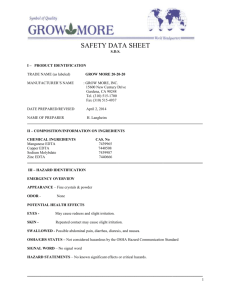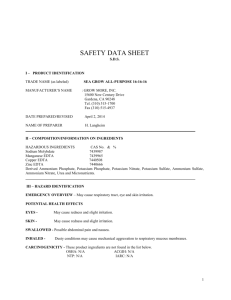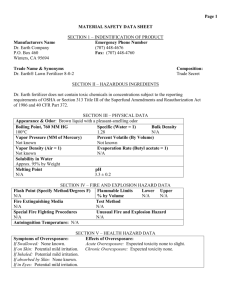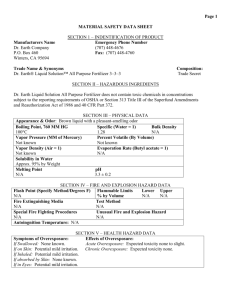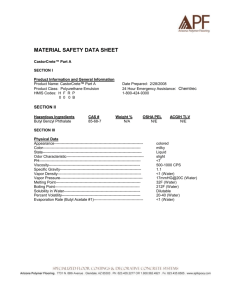Explorer Pipeline Natural Gasoline SDS
advertisement
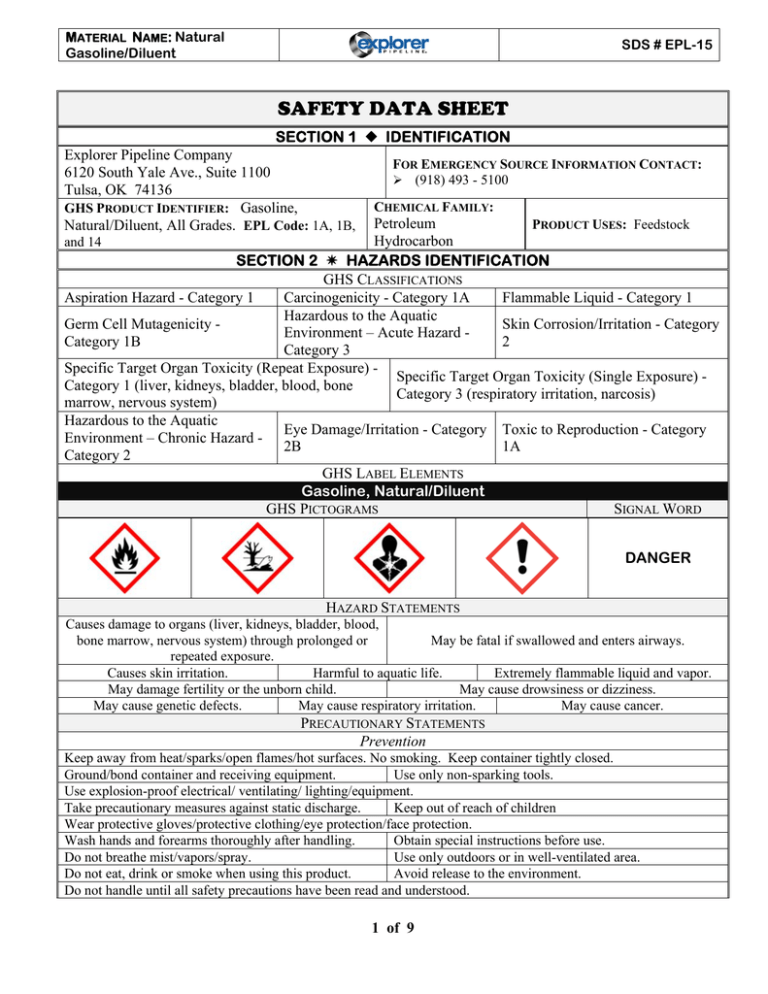
MATERIAL NAME: Natural Gasoline/Diluent SDS # EPL-15 SAFETY DATA SHEET SECTION 1 IDENTIFICATION Explorer Pipeline Company FOR EMERGENCY SOURCE INFORMATION CONTACT: 6120 South Yale Ave., Suite 1100 (918) 493 - 5100 Tulsa, OK 74136 CHEMICAL FAMILY: GHS PRODUCT IDENTIFIER: Gasoline, PRODUCT USES: Feedstock Natural/Diluent, All Grades. EPL Code: 1A, 1B, Petroleum Hydrocarbon and 14 SECTION 2 HAZARDS IDENTIFICATION GHS CLASSIFICATIONS Aspiration Hazard - Category 1 Carcinogenicity - Category 1A Flammable Liquid - Category 1 Hazardous to the Aquatic Germ Cell Mutagenicity Skin Corrosion/Irritation - Category Environment – Acute Hazard Category 1B 2 Category 3 Specific Target Organ Toxicity (Repeat Exposure) Specific Target Organ Toxicity (Single Exposure) Category 1 (liver, kidneys, bladder, blood, bone Category 3 (respiratory irritation, narcosis) marrow, nervous system) Hazardous to the Aquatic Eye Damage/Irritation - Category Toxic to Reproduction - Category Environment – Chronic Hazard 2B 1A Category 2 GHS LABEL ELEMENTS Gasoline, Natural/Diluent GHS PICTOGRAMS SIGNAL WORD DANGER HAZARD STATEMENTS Causes damage to organs (liver, kidneys, bladder, blood, bone marrow, nervous system) through prolonged or May be fatal if swallowed and enters airways. repeated exposure. Causes skin irritation. Harmful to aquatic life. Extremely flammable liquid and vapor. May damage fertility or the unborn child. May cause drowsiness or dizziness. May cause genetic defects. May cause respiratory irritation. May cause cancer. PRECAUTIONARY STATEMENTS Prevention Keep away from heat/sparks/open flames/hot surfaces. No smoking. Keep container tightly closed. Ground/bond container and receiving equipment. Use only non-sparking tools. Use explosion-proof electrical/ ventilating/ lighting/equipment. Take precautionary measures against static discharge. Keep out of reach of children Wear protective gloves/protective clothing/eye protection/face protection. Wash hands and forearms thoroughly after handling. Obtain special instructions before use. Do not breathe mist/vapors/spray. Use only outdoors or in well-ventilated area. Do not eat, drink or smoke when using this product. Avoid release to the environment. Do not handle until all safety precautions have been read and understood. 1 of 9 MATERIAL NAME: Natural Gasoline/Diluent SDS # EPL-15 Response In case of fire: Use foam, dry chemical. Use water spray to cool adjacent tanks and structures. Do not spray water directly on fire. IF exposed or concerned: Get medical advice/attention. IF ON SKIN (or hair): Wash with plenty of soap and water. Remove/Take off immediately all contaminated clothing and wash before reuse. If skin irritation occurs, get medical advice/attention. IF INHALED: Remove victim to fresh air and keep at rest in a position comfortable for breathing. Call a poison control center or doctor/physician if you feel unwell. Get medical advice/attention if you feel unwell. IF SWALLOWED: Immediately call a POISON CENTER or doctor/physician. Do not induce vomiting. Storage Store in a well-ventilated place Keep cool Keep container tightly closed Disposal Dispose of contents/container in accordance with local/regional/national/international regulations. SUPPLIER INFORMATION 6120 South Yale Ave., Suite 1100 Explorer Pipeline Company Tulsa, Oklahoma 74136 SECTION 3 COMPOSITION/INFORMATION OF INGREDIENTS INGREDIENT CAS NUMBER PERCENTAGE (%) n-Pentane Isopentane n-Butane Isobutane C6 Hydrocarbons C7 Hydrocarbons C8 Hydrocarbons Benzene 109-66-0 /78-78-4 75-28-5 / 106-97-8 ---------------------------------- 71-43-2 SECTION 4 FIRST AID MEASURES 25 - 65 1 - 55 1 - 30 1 - 12 1-3 0-2 EYES: Immediately flush eyes with plenty of water for at least 15 minutes, occasionally lifting the upper and lower lids, Get Medical Aid. SKIN: Quickly remove contaminated clothing and immediately flush skin with plenty of soap and water for at least 15 minutes while removing contaminated clothing and shoes. Get medical aid if irritation develops or persists. INGESTION: Do not induce vomiting. Call a physician and/or transport to an emergency facility immediately. INHALATION: Get medical aid immediately. Remove from exposure to fresh air immediately. If not breathing, give cardiopulmonary resuscitation. If breathing is difficult, give medical oxygen. NOTE TO PHYSICIAN: TREAT SYMPTOMATICALLY AND SUPPORTIVELY SECTION 5 FIRE-FIGHTING MEASURES SEE SECTION 9 FOR FLAMMABILITY PROPERTIES EXTREMELY FLAMMABLE! This material releases vapors at or below ambient temperatures. When mixed with air in certain proportions and exposed to an ignition source, these vapors can burn in the open or explode in confined spaces. Being heavier than air, flammable vapors may travel long distances along the ground before reaching a point of ignition and flashing back. SUITABLE EXTINGUISHING MEDIA: Water fog, dry chemical, foam, or Carbon Dioxide. Use water spray to cool nearby containers and structure exposed to fire. Water fog or spray are of value in cooling tanks and containers but may not achieve extinguishment. HAZARDOUS REACTIONS/DECOMPOSITION: Burning or excessive heating may produce carbon monoxide and carbon dioxide, also other harmful gases/vapors including oxides and/or other compounds of chlorine, manganese, and bromine. SPECIAL PROTECTIVE ACTIONS FOR FIREFIGHTERS: For fires involving this material, do not enter any enclosed or confined space without proper protective equipment. This may include self-contained breathing apparatus to protect against the hazardous effects of combustion products and oxygen deficiencies. If firefighters cannot work upwind of 2 of 9 MATERIAL NAME: Natural Gasoline/Diluent SDS # EPL-15 the fire, respiratory protective equipment must be worn. Cool tanks and containers exposed to fire with water. Burning liquid will float on water. Notify appropriate authorities if liquid enters sewer/waterways. SECTION 6 ACCIDENTAL RELEASE MEASURES PERSONAL PRECAUTIONS METHODS FOR CONTAINMENT METHODS FOR CLEANING UP OTHER INFORMATION ELIMINATE all ignition sources (no smoking, flares, sparks or flames in immediate area). Evacuate personnel to safe areas. Use personal protective equipment. All equipment used when handling the product must be grounded. Ensure adequate ventilation. Take precautionary measures against static discharges. Keep people away from and upwind of spill/leak. Stop leak if you can do so without risk. A vapor suppressing foam may be used to reduce vapors. Absorb or cover with dry earth, sand or other non-combustible material and transfer to containers. Dike far ahead of liquid spill for later disposal. Use clean non-sparking tools to collect absorbed material. Dike far ahead of liquid spill for later disposal. Water spray may reduce vapor but may not prevent ignition in closed spaces. SECTION 7 HANDLING AND STORAGE Prior to working with this product workers should be trained on its proper handling and storage PRECAUTIONS FOR SAFETY HANDLING STORAGE PROCEDURES INCOMPATIBILITIES Do not siphon by mouth. Handle as a flammable liquid. Keep away from heat, sparks, and open flame! Electrical equipment should be approved for classified area. Bond and ground containers during product transfer to reduce the possibility of static-initiated fire or explosion. Special slow load procedures for "switch loading" must be followed to avoid the static ignition hazard that can exist when higher flash point material (such as fuel oil) is loaded into tanks previously containing low flash point products (such as this product) - see API Publication 2003, "Protection Against Ignitions Arising Out Of Static, Lightning and Stray Currents." Keep away from flame, sparks, excessive temperatures and open flame. Use approved vented containers. Keep containers closed and clearly labeled. Empty product containers or vessels may contain explosive vapors. Do not pressurize, cut, heat, weld or expose such containers to sources of ignition. Store in a well-ventilated area. This storage area should comply with NFPA 30 "Flammable and Combustible Liquid Code". Avoid storage near incompatible materials. Keep away from strong oxidizers. SECTION 8 EXPOSURE CONTROLS / PERSONAL PROTECTION EXPOSURE LIMITS Chemical Name ACGIH TLV (2013) OSHA PEL n-Pentane TWA: 600 ppm TWA: 1,000 Butane Benzene TWA: None STEL: 1,000 ppm TWA: 0.5 ppm STEL: 2.5 ppm Skin NIOSH IDLH 120 ppm (REL) 1,500 ppm TWA: None 800 ppm (REL) TWA: 1 ppm STEL: 5 500 ppm ENGINEERING CONTROLS: Use adequate ventilation to keep vapor concentrations of this product below occupational exposure limits and flammability limits, particularly in confined areas. 3 of 9 MATERIAL NAME: Natural Gasoline/Diluent SDS # EPL-15 PERSONAL PROTECTIVE EQUIPMENT EYES: Eye protection (ANSI Z87.1 approved) should be worn whenever there is a likelihood of misting or splashing/spraying liquid. Suitable eyewash station should be available. Contact lenses must not be worn. SKIN/BODY: Chemical protective clothing is recommended based on a thorough PPE hazard assessment. Note: The resistance of specific material may vary from product to product as well as with degree of exposure. Consult manufacturer specifications for specific information. HAND PROTECTION: Gloves constructed of nitrile, neoprene, or PVC are recommended. Consult manufacturer specifications for specific information. RESPIRATORY PROTECTION: A NIOSH approved air purifying respirator (APR) with properly selected cartridges may be permissible under certain circumstances where airborne concentrations may exceed exposure limits. Protection provided by APRs is limited, calculate the maximum use concentration for the exposure situation. Use a positive pressure air supplied (Grade D) respirator if there is any potential for an uncontrolled release, exposure levels are not known or any other circumstances where APRs may not provide adequate protection. OTHER HYGIENIC AND WORK PRACTICES: Use good personal hygiene practices. In case of skin contact, wash with mild soap and water or a waterless hand cleaner. Immediately remove soaked clothing and wash thoroughly before reuse. SECTION 9 PHYSICAL AND CHEMICAL PROPERTIES PERCENT VOLATILE BY VOLUME: Slight - 100% BOILING POINT (760 MM HG): 84 F/29 °C SPECIFIC GRAVITY (H2O = 1): 0.6-0.7 VISCOSITY UNITS, TEMP: Unavailable EVAPORATION RATE (BuAc = 1): Unavailable VAPOR DENSITY (AIR =1): >1 SOLUBILITY IN WATER: Negligible VAPOR PRESSURE AT 25C: 510 - 760 mm Hg APPEARANCE AND ODOR: Clear colorless liquid, with hydrocarbon odor. LEL: 1.4% FLAMMABLE LIMITS: FLASH POINT: (Method Used) -70 F/-57 °C UEL: 7.6% AUTOIGNITION TEMPERATURE: 536 °F / 280 °C VOC CONTENT: 100% SECTION 10 STABILITY AND REACTIVITY CHEMICAL STABILITY: Stable under normal temperatures and pressures HAZARDOUS REACTION POTENTIAL: Will not occur CONDITIONS TO AVOID: Avoid high temperatures, open flames, sparks, welding, smoking and other ignition sources. INCOMPATIBLE PRODUCTS: Keep away from strong oxidizers. MATERIALS TO AVOID: Contact with strong acids/oxidizer. HAZARDOUS DECOMPOSITION PRODUCTS: Carbon monoxide, carbon dioxide and non-combusted hydrocarbons (smoke). HAZARDOUS POLYMERIZATION: Has not been reported OTHER PHYSICAL AND CHEMICAL PROPERTIES: If uninhibited, Natural Gasoline/Diluent will cause rusting of copper and alloys containing copper. SECTION 11 TOXICOLOGICAL INFORMATION NATURAL GASOLINE/DILUENT Aspiration of Natural Gasoline/Diluent into the lungs will cause chemical pneumonia. Liquid, mist, or vapors can cause eye, skin and respiratory tract irritation and CNS depression. Mild eye irritation may result from contact with liquid, mist, and/or vapors. Liquid may penetrate skin to cause central nervous system depression. Vapor penetration can also cause systematic effects. Skin irritation or more serious disorders may occur upon prolonged and repeated contact due to skin defatting. Irritation of the mouth, throat, and gastrointestinal tract leading to nausea, vomiting, diarrhea and restlessness. CNS Depression similar to that caused by vapor inhalation. Exposure can cause irritation to the nose, throat, and lungs and signs of CNS depression (dizziness, drowsiness, loss of coordination, coma and death), depending on the concentration/duration of exposure. Long-term exposure to Natural Gasoline/Diluent has also produced kidney 4 of 9 MATERIAL NAME: Natural Gasoline/Diluent SDS # EPL-15 damage in laboratory animals. The exact relationship between these results and possible human effects is not known. Persons with pre-existing skin disorders, impaired liver or kidney function, or CNS and chronic respiratory diseases should avoid exposure to this material. This material may contain benzene at concentrations above 0.1%. Benzene is considered to be a known human carcinogen by OSHA, IARC and NTP. Toxicity Type Of Type Of Type Of Specie Result Specie Result Specie Result Dose Dose Dose Not Not Rat LD50(oral) Rat LD50(dermal) Rabbit LC50(inh) 300 g/M3 Available Available (5 minutes) RTECS #: LX3300000 N-PENTANE Inhalation of very high concentrations of pentane (>10% in air) may cause narcosis and irritation of the mucous membranes (eye, noise, and throat). In humans, inhalation of 5000 ppm for 10 minutes failed to cause these symptoms. There is no report in the literature indicating any adverse effects from pentane other than narcosis and irritation. TOXICITY Type Of Type Of Type Of Specie Result Specie Result Specie Result Dose Dose Dose Rat LD50(oral) Rat 446 g/kg LD50(dermal) Rabbit No Data LC50(inh) 364 g/M3 (4 hours) Specific organ toxicity, single exposure: No data Specific organ toxicity, repeated exposure: Liver damage available CARCINOGENICITY Not Listed IARC Not Listed NTP OSHA: Not California (Prop 65): NIOSH: Not Listed ACGIH: Not Listed Not Listed as carcinogen Listed MUTAGENICITY, TERATOGENICITY AND REPRODUCTIVE EFFECTS Respiratory or Skin sensitization: No data available Germ cell mutagenicity: No data available Reproductive toxicity: No data available Teratogenicity: No data available Skin Corrosion/irritation: Skin-rabbit: skin irritation Serious eye damage, irritation-rabbit: No data available Synergistic effects: No data available Aspiration hazard: No data available RTECS #: RZ9450000 BUTANE Butane is a colorless gas with no odor, although an odorant is sometimes added to the gas to provide warning of its presence. Health effects may include drowsiness, narcosis, asphyxia; cardiac arrhythmia at high concentrations and frostbite from contact with liquid. TOXICITY Type Of Type Of Type Of Specie Result Specie Result Specie Result Dose Dose Dose Mouse Rat LC50(inh) 680 g/M3 LD50(dermal) Rabbit No Data LC50(inh) 658 g/M3 (2 hours) (4 hours) Specific organ toxicity, repeated exposure: may cause Specific organ toxicity, single exposure: May cause damage to organs from repeated or prolonged exposure. drowsiness or dizziness May cause nervous system damage. CARCINOGENICITY Testicular tumors shown in rats. Not Listed IARC Not Listed NTP 5 of 9 MATERIAL NAME: Natural Gasoline/Diluent SDS # EPL-15 OSHA: Not California (Prop 65): NIOSH: Not Listed ACGIH: Not Listed Listed Not listed as carcinogen MUTAGENICITY, TERATOGENICITY AND REPRODUCTIVE EFFECTS Respiratory or Skin sensitization: No data available Germ cell mutagenicity: No data available Reproductive toxicity: No data available Teratogenicity: No data available Skin Corrosion/irritation: Skin-rabbit: skin irritation Serious eye damage, irritation-rabbit: No data available Synergistic effects: No data available Aspiration hazard: No data available RTECS #: EJ4200000 BENZENE Acute inhalation effects may cause respiratory tract irritation drowsiness, unconsciousness, and central nervous system depression. Potential symptoms of overexposure by inhalation are dizziness, headache, vomiting, visual disturbances, staggering gait, hilarity, fatigue, and other symptoms of CNS depression. Chronic exposures may cause bone marrow abnormalities with damage to blood forming tissues. May cause anemia and other blood cell abnormalities. Chronic exposure to benzene has been associated with an increased incidence of leukemia and multiple myeloma (tumor composed of cells of the type normally found in the bone marrow). This substance has caused adverse reproductive and fetal effects in laboratory animals. Toxicity Type Of Type Of Type Of Specie Result Specie Result Specie Result Dose Dose Dose 930 Mouse LD50(dermal) 9,980 ppm LD50(oral) Rat Rabbit 9.4 ml/kg LC50(inh) mg/kg (4 hours) Specific organ toxicity, repeated exposure: may cause Specific organ toxicity, single exposure: May cause damage to organs from repeated or prolonged exposure. drowsiness or dizziness May cause nervous system damage. CARCINOGENICITY Group 1: classifiable as a human Sufficient evidence in animals Sufficient evidence in humans IARC carcinogen Carcinogen NTP NIOSH: Potential ACGIH: A1 - Confirmed human OSHA: Select California (Prop 65): Listed as carcinogen Occupational Carcinogen carcinogen Carcinogen MUTAGENICITY, TERATOGENICITY AND REPRODUCTIVE EFFECTS Germ cell mutagenicity: lab testing shows mutagenic Respiratory or Skin sensitization: No data available effects (in vivo). Genotoxicity in humans (in vivo) lymphocyte. Genotoxic damage shown in mice. Teratogenicity: Rat inhalation include effects include Reproductive toxicity: inhalation toxicity in mouse, stunted fetus and death including embryonic and fetal effects including death Mouse inhalation include effects include cytological changes and abnormalities to blood and lymphatic system. Skin Corrosion/irritation: will cause skin irritation Serious eye damage, irritation -rabbit: mild eye irritation Aspiration hazard: May be fatal if swallowed and enters Synergistic effects: damage to bone marrow airway. RTECS #: CY1400000 SECTION 12 ECOLOGICAL INFORMATION n-PENTANE Type Of Dose Specie LC50 Rainbow trout EC50 Green algae Result 9.87 g/L 96 Hours No Data TOXICITY Type Of Dose 6 of 9 Specie EC50 Water Flea EC50 Microtox Result 9.7 g/L 48 Hours No Data MATERIAL NAME: Natural Gasoline/Diluent SDS # EPL-15 Log Pow 3.39 BCF 1.9-2.35 BUTANE Type Of Dose LC50 EC50 Specie fathead minnow Green algae Log Low TOXICITY Result Type Of Dose No Data EC50 No Data EC50 BIOACCUMULATIVE POTENTIAL 2.89 BCF Specie Water Flea Microtox Result No Data No Data 1.78 - 1.97 BENZENE Type Of Dose Specie LC50 fathead minnow EC50 Green algae Log Pow TOXICITY Result Type Of Dose 15-32 mg/L EC50 96 hours 29 mg/L EC50 72 Hours BIOACCUMULATIVE POTENTIAL 1.83 BCF Specie Result 10 mg/L 48 Hours Water Flea Microtox No Data 4.265 SECTION 13 DISPOSAL CONSIDERATIONS Not Meant To Be All Inclusive - Check Local, State, And Federal Laws And Regulations Maximize product recovery for reclaim and reuse. Implement waste minimization principles. EPA U.S. Waste Codes: “Ignitable hazardous waste” (D001 and D018), unless proven otherwise. Use approved treatment, transporters, and disposal sites in compliance with all laws. Waste Disposal Method: Should not be released into the environment. Contaminated Packaging: Dispose of in accordance with local regulations. US EPA Waste Number: D018 and D001 SECTION 14 TRANSPORTATION INFORMATION Not Meant To Be All Inclusive - Check Local, State, And Federal Laws And Regulations Element U.S. DOT IMDG IATA UN Number UN 1993 UN 1993 UN 1993 UN Proper Shipping Name Flammable Liquids, N.O.S. (Pentane, Butane) Flammable Liquids, N.O.S. (Pentane, Butane) Flammable Liquids, N.O.S. (Pentane, Butane) Hazard Class 3 3 3 Environmental Hazard Yes Yes Yes Packing Group I I I Placard/Label 7 of 9 MATERIAL NAME: Natural Gasoline/Diluent SDS # EPL-15 SECTION 15 REGULATORY INFORMATION Listing Agency Guidance only, consult specific regulations OSHA CERCLA RQ’s (40 CFR Part 102) TSCA 8(a) TSCA 8(b) SARA (40 CFR Part 355) TPQ’s SARA 302/304/311/312 extremely hazardous substances SARA 302/304 emergency planning and notification SARA 302/304/311/312 hazardous chemicals RCRA State Regulations: Massachusetts, New Jersey, New York and Pennsylvania All ingredients are listed as hazardous under 29 CFR 1910.1200 Benzene – 10 pounds All components are listed or exempted All components are listed or exempted None of the ingredients are listed None of the ingredients are listed None of the ingredients are listed Natural Gasoline/Diluent Benzene - U019 Natural Gasoline/Diluent, Butane, Benzene and Pentane SARA 311/312 SDS distribution - chemical inventory - hazard identification EPA Form R Toxic Chemical Release Inventory Clean Water Act (CWA) 307 Clean Water Act (CWA) 311 Clean Air Act Section 112(b) Hazardous Air Pollutants (HAPs) Clean Air Act Section 602 Class I Substances Clean Air Act Section 602 Class II Substances Natural Gasoline/Diluent: Fire hazard, Immediate (acute) health hazard, Delayed (chronic) health hazard; Benzene: Fire hazard, Immediate (acute) health hazard, Delayed (chronic) health hazard; Butane: Fire hazard, and Pentane: Fire hazard. Benzene Benzene Benzene Listed Not Listed Not Listed SECTION 16 OTHER INFORMATION HMIS III LABEL Personal Protection Index NPCA recommends that PPE codes be determined by the employer, who is familiar with the actual conditions under which chemicals in the facility are used. NFPA LABEL Acronym List F=degrees Fahrenheit °C=degrees Celsius APR=Air Purifying Respirator BCF= Bioconcentration Factor 8 of 9 ACGIH= American Conference of Industrial Hygienists BuAc=Butyl Acetate MATERIAL NAME: Natural Gasoline/Diluent SDS # EPL-15 CANUTEC= Canadian Transport Emergency Centre CAS=Chemical Abstract Service CERCLA= Comprehensive Environmental Response, Compensation, and Liability Act CHEMTREC= Chemical Transportation Emergency Center CNS=Central Nervous System CWA=Clean Water Act DOT=Department of Transportation EC50= Effective Concentration Fifty g/Kg=Grams per Kilogram g/M3=Grams per Cubic Meter H2O=Water HAP=Hazardous Air Pollutants IARC= International Agency for Research on Cancer LC50=Lethal Concentration Fifty Log Pow =Octanol/water partition coefficient IATA= International Air Transport Association LD50=Lethal Dose Fifty EPA=Environmental Protection Agency GHS=Global Harmonization System HMIS= Hazardous Materials Identification System IMDG= International Maritime Dangerous Goods LEL=Lower Explosive Limit mg/Kg=Milligrams per Kilogram mg/L=Milligrams per Liter mL/Kg=Milliliters per Kilogram mm HG=millimeters of mercury NIOSH= National Institute for Occupational Safety and Health NTP=National Toxicology Program PEL=Permissible Exposure Limit ppm=Parts per Million RQ=Reportable Quantities RTECS=Registry of Toxic Effects of Chemical Substances SARA= Superfund Amendments and Reauthorization Act SDS=Safety Data Sheet STEL=Short Term Exposure Limit TLV=Threshold Limit Value TSCA=Toxic Substance and Control TWA=Time Weighted Average Act VOC=Volatile Organic Compounds SDS REVISIONS: Reformatted to meet GHS Requirements SDS CREATION DATE: 04/15/14 REVISION #0: NFPA=National Fire Protection Association OSHA=Occupational Safety and Health Administration RCRA=Resource Conservation and Recovery Act REL=Recommended Exposure Limit SETIQ= Emergency Transportation System for the Chemical Industry; Mexico TPQ=Threshold Planning Quantity UEL=Upper Explosive Limit 04/15/14 DISCLAIMER The information in this SDS was obtained from sources which we believe are reliable. HOWEVER, THE INFORMATION IS PROVIDED WITHOUT ANY WARRANTY, EXPRESSED OR IMPLIED, REGARDING ITS ACCURACY. Some conditions or methods of handling, storage, use and disposal of the product are beyond our control and may be beyond our knowledge. FOR THIS AND OTHER REASONS, WE DO NOT ASSUME RESPONSIBILITY AND EXPRESSLY DISCLAIM LIABILITY FOR LOSS, DAMAGE OR EXPENSE ARISING OUT OF OR IN ANY WAY CONNECTED WITH THE HANDLING, STORAGE, USE OR DISPOSAL OF THE PRODUCT. All product measurements such as flash point, etc. are considered approximate values. All data provided by Explorer Pipeline Company. This SDS was prepared and is to be used only for this product. DATE: 04/15/14 SDS DEVELOPER: Cass Willard, CIH 9 of 9
